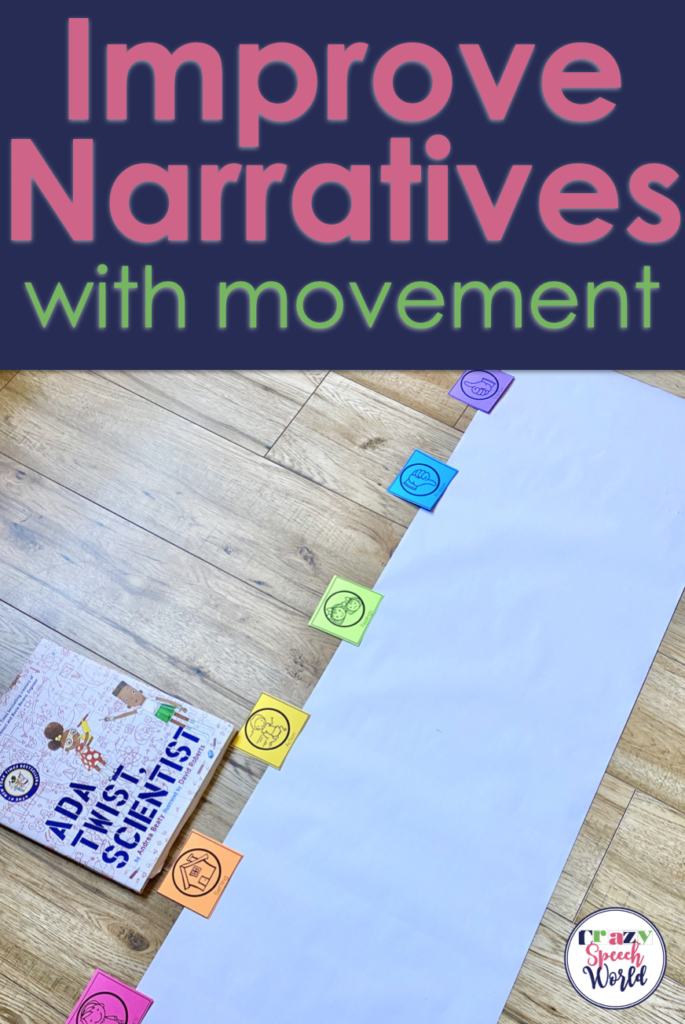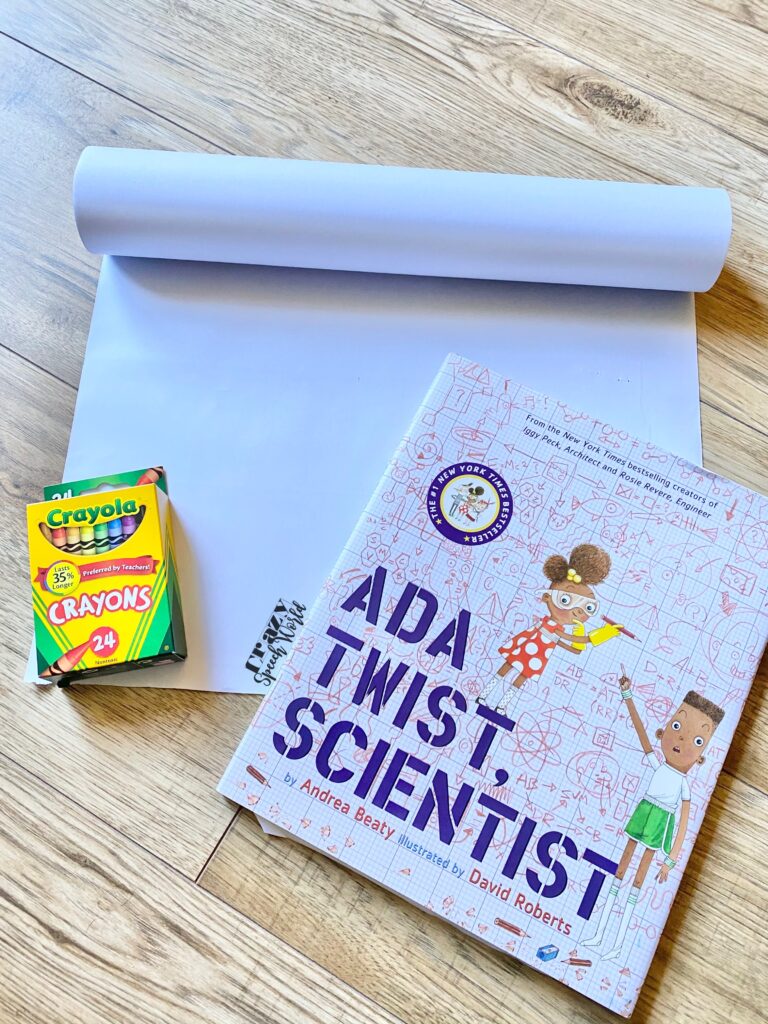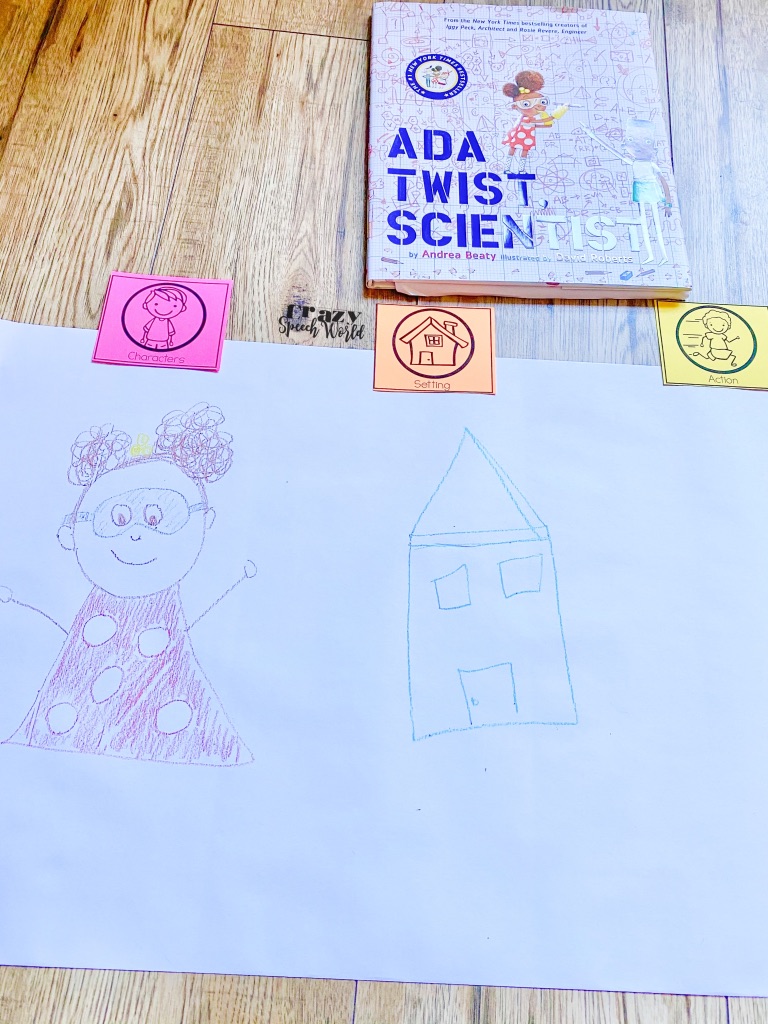
Brain compatible learning… what does that mean?? We know that there is a ton of research showing us that allowing children to use their body in movement or multisensory exploration increases their ability to learn a skill. So using brain compatible learning means that you are going to incorporate movement and the arts into learning activities or academics (Jensen, 2005).
You guys already know how much I love literacy based therapy, but I think a lot of times we think that means reading a book, discussion, and then back to class. How can we incorporate more of these brain compatible learning strategies to help our students learn the speech and language skills they require to be successful? Get away from your table and chairs!

This activity is super easy to do with what you already have. Grab a book and some paper. You can use story grammar visuals (I used the one included in this resource) should your students need that level of support. Each students gets their own set in a different color. Then you assign each of them a part of the story.
If you need to keep your students socially distanced, then you could give them a separate piece of paper and they draw their picture. Then everyone can hold their picture up when it’s time to tell that part of the story.
For virtual students, I would send the visuals to the parent, have them print them (or pick them up from school if they don’t have a printer) and then spread them out on their floor and have the student retell.

I would give them 5 minutes to draw a picture/write words or sentences for each part of the story. Then, when they are done, each student can take turns jumping along the story map the group has made and retell the story. This also allows them to work as a collaborative group, encouraging discussion and conversation about the story.
What do you think? Is this something you can do in your classroom?




![Using open ended activities and games in speech therapy can make planning sessions so much easier! Here are a few suggestions that worked well for me. Do you remember the first time you were faced with a mixed group and were realllllllllly unsure about what to do? I do… picture it, St. Augustine 2007 😅 I was […]](https://i.pinimg.com/236x/db/72/cf/db72cf1f6f5da00cb2a13a90872871ea.jpg)
![Using open ended activities and games in speech therapy can make planning sessions so much easier! Here are a few suggestions that worked well for me. Do you remember the first time you were faced with a mixed group and were realllllllllly unsure about what to do? I do… picture it, St. Augustine 2007 😅 I was […]](https://i.pinimg.com/236x/ae/c5/56/aec55688010e2d3489baf744dde59582.jpg)
![Using open ended activities and games in speech therapy can make planning sessions so much easier! Here are a few suggestions that worked well for me. Do you remember the first time you were faced with a mixed group and were realllllllllly unsure about what to do? I do… picture it, St. Augustine 2007 😅 I was […]](https://i.pinimg.com/236x/18/b9/e8/18b9e80227dfe1789e20a21629254f79.jpg)
![Using open ended activities and games in speech therapy can make planning sessions so much easier! Here are a few suggestions that worked well for me. Do you remember the first time you were faced with a mixed group and were realllllllllly unsure about what to do? I do… picture it, St. Augustine 2007 😅 I was […]](https://i.pinimg.com/236x/4d/34/85/4d3485a753178d000223a89b09162317.jpg)
![Using open ended activities and games in speech therapy can make planning sessions so much easier! Here are a few suggestions that worked well for me. Do you remember the first time you were faced with a mixed group and were realllllllllly unsure about what to do? I do… picture it, St. Augustine 2007 😅 I was […]](https://i.pinimg.com/236x/da/7b/c1/da7bc16b9530451d989a578236bc2bff.jpg)
![Using open ended activities and games in speech therapy can make planning sessions so much easier! Here are a few suggestions that worked well for me. Do you remember the first time you were faced with a mixed group and were realllllllllly unsure about what to do? I do… picture it, St. Augustine 2007 😅 I was […]](https://i.pinimg.com/236x/e0/21/a4/e021a465474b16201d23d0a77857935b.jpg)
![Using open ended activities and games in speech therapy can make planning sessions so much easier! Here are a few suggestions that worked well for me. Do you remember the first time you were faced with a mixed group and were realllllllllly unsure about what to do? I do… picture it, St. Augustine 2007 😅 I was […]](https://i.pinimg.com/236x/fa/94/be/fa94be15b6f184b64e2e408bc762a7e8.jpg)
